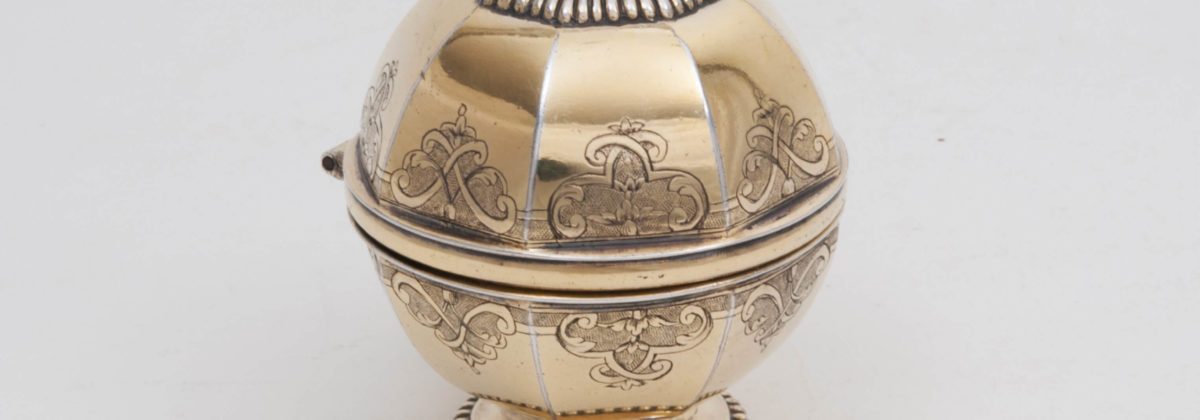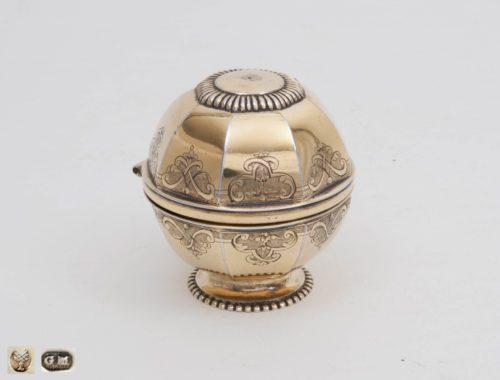Detailed description
German Soap Box of the Régence, Silver Gilt
This German silver soap box is silver, fully gilt and was produced in Augsburg during the Régence period, i.e. at the beginning of the 18th century. The eight-sided, faceted body, which has basically a spherical form, stands on a retracted foot decorated with a frieze of godrons. The container closes with a hinge and is decorated on both sides of the hemisphere with chiseled Régence decoration on a punched ground. On the end of the upper hemisphere a godron-frieze beautifully repeats the decoration of the foot. The marks are ligated at the bottom of the foot as the control stitch (zig-zag).
Soap Boxes made in Silver
In the 18th century, the use of toilet services was prevalent; this meant a widespread production and use of boxes as well: powder boxes, boxes for beauty pads (Fr.: boîtes à mouches), sponge boxes/containers and soap boxes/containers are just a few examples. These small containers – often very luxuriously manufactured – were also popular gifts and are mentioned again and again in inventories from the century of the Enlightenment.
Spherical containers for toilet services were often made in pairs. This custom spread from Paris and France to various goldsmith production centers in Europe. One of the boxes was decorated with pierces and was used to store the sponge. The unpierced box was used for storing the soap. These two containers were often accompanied by a shaving basin, so that it can be concluded that such objects often belonged to men’s toilet services.
However, soap has been produced since ancient times and was very expensive in Europe in the 16th and 17th centuries. Large export countries of soaps were above all France (Toulon, Marseille), Italy (Naples) and Spain, where soap was produced on basis of olive oil. In the 18th century soap was sold in small balls, so the corresponding storage box took a spherical shape. Towards the end of the century, the French chemist Nicholas Leblanc invented a process to produce soap from salt. This gave the product a harder consistency and made it easier to perfume.
Compare a beautiful French pair of sponge and soap containers, see in The Metropolitan Museum.
Maker
Gottlieb Menzel was one of Augsburg’s leading goldsmiths in the first half of the 18th century. Gottlieb Menzel was born in 1676 in Wroclaw, was since 1709 active as a master silversmith and died in 1757. He mainly produced tableware for an aristocratic clientele. His clients include August the Strong, Landgrave Ernst Ludwig of Hesse-Darmstadt, Queen Louise of Denmark and the Viennese Court.
Literature
Havard, Henry, Dictionnaire de l’ameublement et de la décoration : depuis le XIIIe siècle jusqu’à nos jours, Bd. I, A-C, Paris: Maison Quantin, 1894, p. 343-350.
Seling, Helmut, Die Augsburger Gold- und Silberschmiede 1529-1868, Bd. I-III, München: Beck Verlag, 1980-2007



